That living things can keep their generation going can only be possible through the perfect functioning of their reproductive systems. It is, however, not enough for men and animals to have reproductive systems; they also need a special instinct, namely the sexual instinct, which makes reproduction attractive. Otherwise, despite having the chance to reproduce, most animals would not attempt it. As well as that, once they become aware of the difficulties of birth, laying eggs and the subsequent incubation period, they would avoid involvement in the sexual act, which is the cause of everything that follows.
The sexual drive is not enough by itself either. Although living beings copulate and bring new living beings into the world, their species is still likely to become extinct if they were not created possessing the instinct to protect and care for their young. If parental affection, as possessed by most living species, did not exist, species would become extinct. At this point, those who advocate evolution talk about "the consciousness of breeding generations". According to them, just as every individual spends a considerable effort to protect itself, so must it spend an effort to breed its species. However, it is evident that an animal cannot think, "my generation must continue after me, so I have to do what I can". The animal protects and cares for its offspring not because it hopes for something or expects some future benefits, but because it was created so.
On the contrary, some living things lack such affection and abandon their offspring as soon as they bring them into the world. These animals produce many offspring at a time and some of them survive without any protection. If they were created with a drive to protect their offspring, there would be a population explosion in their species and the balance of nature would be disturbed.
In short, reproduction, the prerequisite for the continuation of life, is a system Allah created for life to continue. Allah is the "Life-Giver". He is the One Who has brought all living things into being and He is the One Who brings new living beings out from those He created. All living things live thanks to Him. They owe their lives not to their parents, as generally supposed, but to Allah Who created their parents as well as them. In the Qur’an, Allah says:
It is He Who dispersed you about the earth and you will be gathered to Him. (Surat al-Muminun: 79)
In the following pages, we will review some reproductive systems, which Allah granted some living beings. These living things face great difficulties in guaranteeing the continuation of their species. They unquestionably do what they do, not because they employ logic such as "we have to guarantee the continuity of our species", but from the affection and mercy Allah granted to them.
These animals, that have some striking systems, are only a few examples. In fact, the reproduction of each living thing is a miracle on its own.
This wasp species feeds its offspring with the larvae of another wasp species called the sirex. It faces a problem though: sirex spends its larval period about 4 centimetres beneath a tree bark. For this reason, the mother driller wasp has first to locate the sirex larvae, which it cannot see.
To locate the sirex larvae, the bee uses the very sensitive sensors placed in its body and thus the first problem, namely, finding the location of the larvae, is solved. What about the second?... It overcomes this by drilling the tree bark.
The organ, which the wasp uses to drill the tree bark, is called the "Ovipositor". This special organ is longer than the entire body of the wasp. It is formed by the combination of two appendages coming out of the tail, and it has a sharp end like that of a knife. The end of the ‘knife’ has a nicked structure in accordance with its purpose.
As soon as the drilling wasp locates the sirex under the bark, it directs its drilling appendages towards the target in the shortest, most direct way possible. The two appendages drill the bark by moving back and forth like a saw. As soon as the wasp reaches the sirex, it places its own egg through its funnel in the larva.
The young wasp starts its life by growing up in the larva found by its mother and left to it both as a source of food and shelter. Is it still necessary to further accentuate that such perfect design can never be the result of random chance, but on the contrary, is the work of a Creator, of Allah, the Owner of eternal wisdom and might?
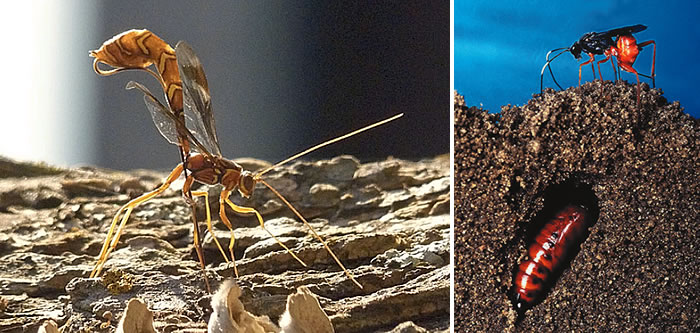 |
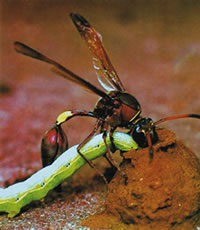 |
The wasp in the picture feeds its larvae in its nest, which it has made of mud with great adeptness.
First, it finds a fleshy caterpillar and stings it at nine key points pertaining to its movement centre. Because of this operation, the caterpillar does not die but is paralysed and can no longer move.
The wasp then very carefully carries the caterpillar, which is as motionless as if it was dead, into its nest.
The paralysed caterpillar meets the wasp larvae’s needs for meat until they grow old enough to leave the nest.
The temperature at the Antarctic polar circle where penguins live can sometimes be as low as -40oC. The bodies of penguins are covered with a thick layer of fat so that they can survive in such a freezing environment. Besides, they have a highly developed digestive system that is able to break food down very rapidly. These two factors furnish penguins with a body temperature of +40o C that makes them indifferent to cold.
Penguins incubate during the polar winter. Furthermore, it is not the female but the male penguins that incubate. Apart from the freezing cold falling down to -40o C, the penguin couple are also faced with glaciers at this time of the year. Throughout winter, the glaciers steadily grow, thereby increasing the distance between the incubation site and the coast, where the closest source of food for the penguins is found. This distance may at times be more than 100 km.
Female penguins lay only one egg, leave incubation to their males and return to the sea. During four months of incubation, the male penguin has to resist violent polar storms at times reaching speeds of 100 km per hour. Because it guards the egg, it has no chance to hunt. In any case, the nearest source of food is at a distance of a couple of days’ journey. Lying for four full months without eating anything, the male penguin loses half of its weight, but it never leaves the egg. Although it goes without any food for months, it does not go hunting, but resists the hunger.
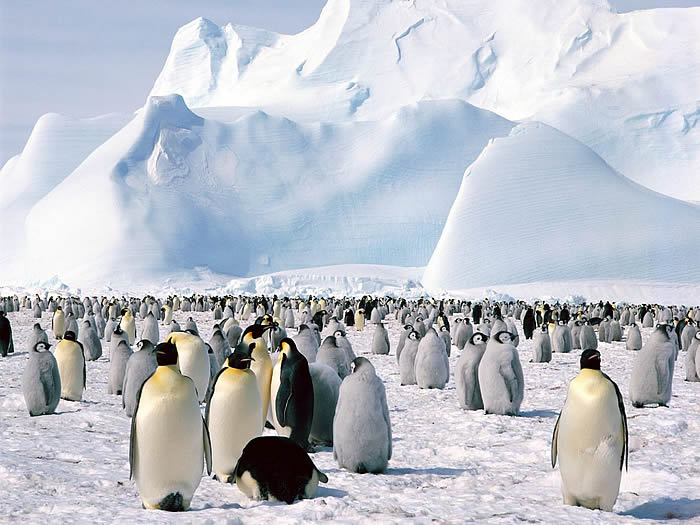 |
| In order to protect themselves from the polar climate that is extremely cold, penguins assemble closer together. Thus, the young members of the community get the chance to meet while being protected from the effect of cold winds. |
After the end of four months when the eggs start to crack open, the female penguin suddenly shows up. In the duration, she has not wasted time but worked for her young and stored food for it.
Among hundreds of penguins, the mother easily finds her spouse and offspring. As the mother has constantly hunted in the meantime, it has a full stomach. It empties its stomach and takes over the job of caring for the young.
In spring, the glaciers start to melt and holes emerge in the ice under which the sea appears. The parent penguins soon start to hunt fish in these holes and feed their young.
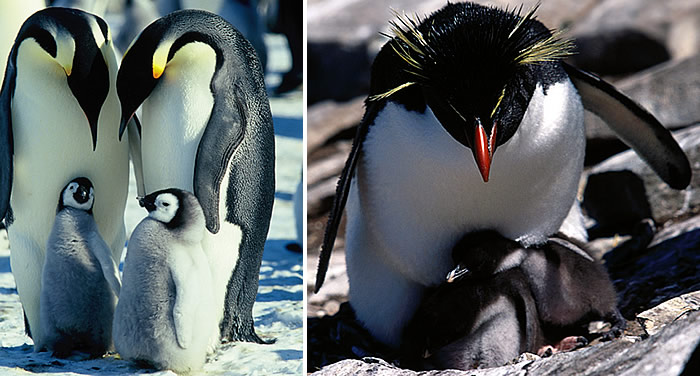 |
| If nature were indeed the way Darwin said it was, that is, if every individual were concerned only with its own life, then no living thing would spend so much time and energy, and suffer from so much hunger to protect and feed its offspring. |
 |
Feeding the baby is a tough task; sometimes the parents do not eat anything for a long time in order to feed the young. There is no way to make a nest when everything is covered with ice. The only thing the parents can do to protect their offspring from the ice cold is to put it on top of their feet and warm it with their tummy.
Timing is also very important in laying eggs.
Why do the penguins lay eggs in winter, and not in summer? There is one reason for this: if they had laid eggs in summer time, then the development of the offspring would take place in winter time and the seas would be frozen. In that case, the parents would have difficulty in finding food to feed the young due to the inconvenient weather conditions and due to the fact that the seas, the food resource of the penguins, are further away.
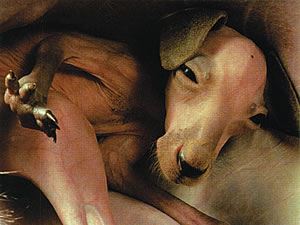 |
The reproductive system of kangaroos is quite different from that of other mammals. The kangaroo embryo goes through some stages outside the womb, which normally occur in the womb.
Soon after fertilisation, the blind kangaroo offspring, which is approximately a centimetre, comes into the world. Usually, only one is born at a time. At this stage, it is called "neonate." While all mammals go through this stage in the mother’s womb, the kangaroo offspring comes into the world when it is only one centimetre long. It has still not developed: its fore feet are indefinite and its hind feet are comprised of small projections.
No doubt, the offspring cannot leave its mother in such a state. Coming out of the womb, the neonate starts to move up in its mother's fur with its fore legs and reaches to its mother’s pouch after a three-minute journey. To the little kangaroo, the pouch means the same as the womb means to other mammals. Yet, there is an important difference. While others come into the world as babies, the kangaroo is merely an embryo when it comes out of the womb. Its feet, face and many other organs have not yet taken their final shapes.
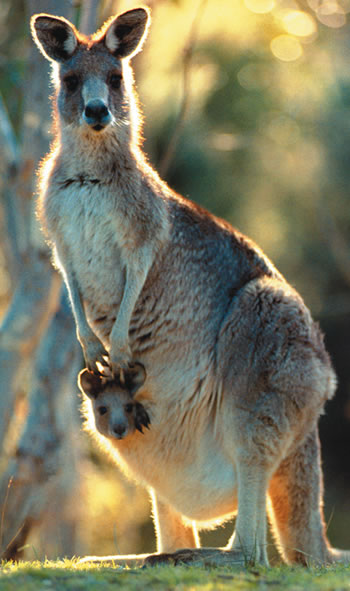 |
The offspring reaching the mother’s pouch attaches itself to one of the four nipples there, and starts to suckle.
At this stage, the mother goes through another ovulation period and a new egg forms in its womb. The female copulates once more and the new egg is fertilised.
This time the egg does not start to develop immediately. If drought rages in Middle Australia, as is often the case, the fertilised egg in the womb remains undeveloped until the drought is over. If, however, heavy rains fall and if there are rich pastures available, then the development of the egg restarts.
At this stage, we are faced with the question: who makes this calculation; who arranges the development of the egg according to the conditions outside? The egg cannot by any means make this arrangement itself; it is not a complete living being, it has no consciousness, and it is totally unaware of the weather conditions outside. The mother cannot make this arrangement, because, like all other living things, it has no control over the developments taking place in its body. Allah, Who has created both the egg and the mother, definitely controls this extraordinary event..
When weather conditions are convenient, thirty-three days after fertilisation, the new neonate, only as big as a bean, creeps up from the mouth of the womb and reaches the pouch just like its sibling did.
In the meantime, the first neonate in the pouch has grown considerably. It leads its life without doing any harm to its sibling, which is only one centimetre long. When it is 190 days old, it has grown mature enough to make its first journey outside the pouch. From then on, it starts to spend most of its time outside the pouch and leaves the pouch for good on the 235th day after its birth.
Soon after the birth of its second offspring, the female copulates again. Consequently, the female has three offspring all dependent on her. The first can feed on grass but occasionally comes back to its mother to suckle; the second younger offspring is still developing by suckling; the third is the neonate, which is the youngest.
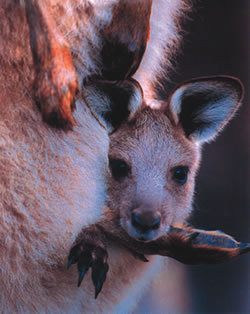 |
What is more astonishing than that all three offspring, each in a different stage of development, are dependent on the mother, is that all three offspring are fed by different types of milk according to their sizes.
While the milk the offspring suckles as soon as it reaches the nipple in the pouch is transparent and colourless, it increasingly turns whiter and starts to look like real milk. The amount of fat and other ingredients in the milk increases in parallel with the development of the baby.
As this young one keeps on suckling the milk prepared for its own needs, a more easily digestible milk issues from the nipple that the second baby reaches. Thus, the body of the mother simultaneously produces two types of milk with different ingredients. When the third is born, the number of milk types produced with different ingredients becomes three: highly nutritious milk for the older, and relatively less fatty and nutritious types of milk for the younger. Another point to note here is that each offspring finds the nipple specially prepared for itself. Otherwise, it would suckle milk with an ingredient likely to be harmful to its body, and the milk it suckles would harm it.
This feeding system is very remarkable and it is obviously a special product of creation. The mother cannot, by any means, arrange all these consciously. How can an animal specify the ingredients of milk needed by its young of different sizes? Even if it did, how could it produce it in its own body? How could it distribute these through three different channels?
Doubtless, the kangaroo is not capable of doing any of these. It is not even aware that the milk delivered by its body is of three different types. This wonderful process is unquestionably an outcome of Allah's superior creation.
 |
| No female becomes pregnant or gives birth except with His knowledge. And no living thing lives long or has its life cut short without that being in a Book. That is easy for Allah. |
The care provided by the crocodile, a wild animal of rivers, for its offspring is quite astounding.
First, the animal digs a hole for the incubation of its eggs. The temperature of the hole should never rise above 30oC. A slight rise in temperature would be a threat to the lives of the offspring in the eggs. The crocodile takes precaution that the holes in which it places its eggs are located in rather shady places. This, however, may not in itself be sufficient. For this reason, the female crocodile spends extraordinary efforts to keep the eggs at a constant temperature.
Some crocodile species build nests of weed on cold water, rather than digging holes (as seen in the picture to the left). If the temperature of the nest still rises despite these measures, then the crocodile cools the nest by sprinkling urea on it. When the eggs are about to crack, loud noises arise from the nest. These noises warn the mother that the critical moment has come. The mother crocodile brings the eggs out and helps the offspring pop out of their eggs by using its teeth as tweezers. The safest place for the newly born is the protective pouch in its mother's mouth specially designed to shelter half a dozen newly born crocodiles.
As seen, there is great co-operation and self-sacrifice among animals. For a sensible person, the perfect harmony in nature clearly reveals signs of the being of a superior Creator. That is, the signs of Allah, Who is the Creator of everything in the heavens and on the earth.
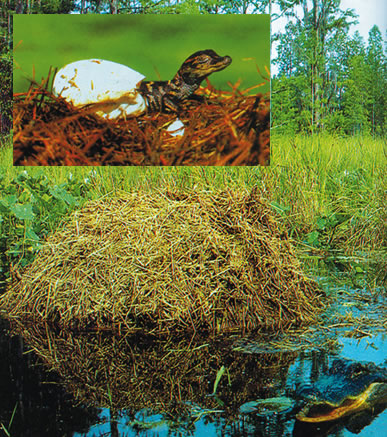 | 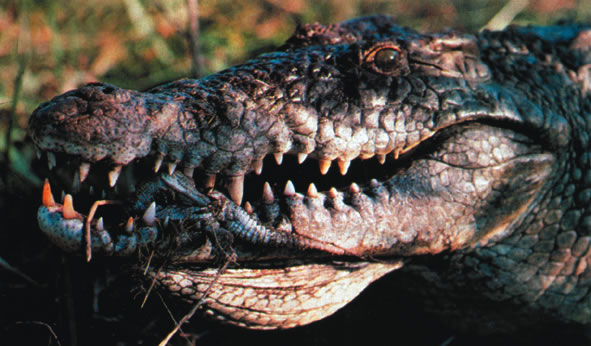 |
| (Right) Despite its bulky and wild look, the mother crocodile provides the utmost care for its young. It offers safe shelter to its unprotected babies in a special pouch in its mouth. | |
| (Left) A Nest of Weeds |
A bird called the "megapode" living in the Pacific islands prepares an interesting "incubation machine" for its offspring.
During the summer season, the female megapode lays one egg every six days. However, the eggs of the megapode are relatively big compared to its size, being almost as big as an ostrich egg. For this reason, the female megapode can only incubate one egg. Therefore, every six days, the new hatched eggs are in danger of dying due to lack of heat. However, this is not a problem for the megapode, because the male megapode is created with the skill to manufacture an incubation machine by using the most abundant materials in nature, that is, sand and earth.
For this purpose, six months before the spawning season comes, the male megapode starts to dig a hole 5 metres in diameter and 1 metre in depth with its gigantic claws. Then, it fills the hole with wet weed and leaves. The main purpose is to use the heat produced by the bacteria in decaying plants to warm the eggs.
However, additional arrangements have to be made for this process to take place. The actual reason why plants decay and release heat is the funnel-shaped hole made by the megapode in the pile of plants. This hole enables rainwater to leak into the nest and keep the organic substances wet. Because of the damp, decay takes place in the plants beneath the sand, and heat is released. Soon before spring, the drought season for Australia starts, and the male begins to air the decayed plant layer. This is to maintain the heat balance. The female bird occasionally visits the hole and checks whether the male is working or not. Finally, the female lays eggs on the sand over the decayed plants.
 |
| The male megapode digs a hole for its eggs. |
For the development of offspring in the "incubation machine", the temperature should be kept constant at +33oC. In order to achieve this, the male megapode regularly measures the temperature of the sand with its beak, which is as sensitive as a thermometer. If necessary, it opens ventilation holes to reduce the temperature. It is so much so that if a few handfuls of earth are thrown on the sand, the male megapode immediately removes the extra sand with its feet and prevents even the slightest change in temperature. The offspring come into the world under such protective measures. The newly born are so developed that they can fly just a few hours after they pop out of their eggs.
How have these creatures accomplished such a job for millions of years which even men could hardly do? Since we know that animals have no conscious rational intellect as people do, the only explanation of this event is that this creature is specially "programmed" for this task, and originally created able to do it. Otherwise, it is impossible to explain how it could prepare for this job six months in advance, or know the nature of this complex chemical process. Why it embarks on such a difficult task to protect the eggs is another question. The only answer is hidden in the desire to reproduce and protect the young.
Did you know that the cuckoo bird lays its eggs in other birds' nests and tricks those birds into looking after its offspring?
When the time to lay eggs comes, the female cuckoo bird seems to race with time. Alert and on watch, the bird hides among the leaves and spies on other birds that build nests. When it sees a familiar bird building a nest, it decides when to lay its own egg. The bird to look after the offspring is now decided upon.
When the cuckoo bird sees that the other bird lays its eggs, it swings into action. As soon as the other bird leaves the nest, the cuckoo immediately flies to the nest and drops its own egg in. Here, it does something very intelligent and throws out one of the actual eggs belonging to the nest. This prevents the owner of the nest from having any doubts.
 |
| The female cuckoo bird lays its eggs next to the eggs of another bird. For this, it observes at length a nest it chooses. As soon as the owner of the nest leaves, it secretly drops an egg in the nest. Meanwhile, it throws one of the eggs in the nest out so that the situation goes unnoticed. |
The mother cuckoo works out a remarkable strategy with perfect timing to guarantee that its offspring makes a safe start in life. The female cuckoo lays not one egg but twenty eggs in a season. Accordingly, it has to find many nursing parents, spy on them and devise good timing to lay its eggs. Since the mother cuckoo lays one egg every two days and it takes five days for each egg to be formed in the ovary, the bird has no time to lose.
Popping out of the egg after an incubation period of twelve days, the cuckoo bird faces its very affectionate - yet not its own - parents as soon as it opens its eyes for the first time after four days. The first thing it does, as soon as it pops out of the egg, is to throw the other eggs out of the nest when the parents are away. The nursing parents carefully feed the offspring, which they take to be theirs. Towards week six when the offspring leaves the nest, we encounter the interesting sight of the cuckoo, a big bird fed by two small birds.
Let us think about why the cuckoo bird leaves its offspring to the care of other birds. Does the mother cuckoo have recourse to such a practice because it is too lazy or because it is not skilful enough to build a nest? Alternatively, is it because that once it used to build nests and look after its own offspring, but then realised that this is a very arduous task, and then it discovered this method? Do you think that a bird can make such a plan on its own? Surely none of these assumptions are true. What this living thing will do is inspired in it. Like all other living things, the cuckoos also do what Allah commands them to.
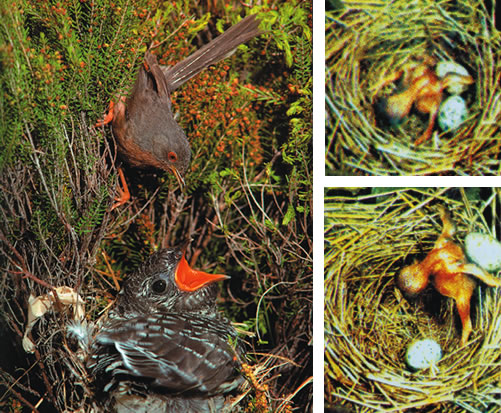 |
Which is the Offspring? |
| Although six weeks pass by, and the offspring grows to be a few times bigger than it was, the nursing bird meticulously carries out its maternal duty. The first thing the cuckoo offspring does when it pops out of the egg is to throw other eggs out of the nest. Thus, the nursing parents will feed only the young cuckoo. |
During the reproductive season, the giant wasp called "pepsis" does not bother with building a nest or incubating, contrary to other animals. It is equipped with a totally different reproductive mechanism by its nature. This wasp feeds and protects its eggs by using the biggest and most poisonous spider on earth called the tarantula.
Tarantulas generally hide themselves in the tunnels they dig underground. This wasp, however, is equipped with special sensors sensitive to the smell of the tarantula. Therefore, it is not so difficult for it to find its prey. The tarantula, however, is not a creature that is often found. For this reason, the wasp sometimes has to walk for hours on the ground to find a single tarantula. During this trip, it does not neglect to clean its sensors regularly so that they do not lose their sensitivity.
When the wasp finds the tarantula, a war breaks out. The main weapon of the tarantula is its fatal poison. At the outset of the struggle, the tarantula immediately bites the wasp. Yet these wasps (pepsis) are protected against the poison of the tarantula by possession of a special antidote and they are not affected by the strong poison of the tarantula owing to that special secretion in their body.
At this stage, the tarantula has nothing more to do against the wasp. It is now the wasp's turn to bite. The wasp bites the tarantula on the upper left part of its stomach and discharges its poison there. It is interesting that the wasp especially chooses this part in the tarantula’s body, because this is the most sensitive section of the tarantula. The most interesting part of the event starts after this stage: the poison of the wasp is placed in its body not to kill the tarantula but to paralyse it.
 |
| The wasp bites the tarantula on the upper left part of its stomach. This is the most appropriate area for the tarantula to be paralysed. |
Carrying the paralysed tarantula to a suitable place, the wasp digs a hole there and puts the tarantula in the hole. Then the wasp makes a hole in the stomach of the tarantula and leaves only one egg in it.
Within a few days, the offspring of the pepsis pops out of the egg. The offspring feeds on the flesh of the tarantula and takes shelter in its body until the cocoon period when it will undergo metamorphosis.
The pepsis has to find a tarantula for each one of the twenty eggs it will lay throughout the reproductive season.
This incredible method shows us that the reproductive system of this wasp is specially created in accordance with the nature of the tarantula. Otherwise, it is by no means possible to explain the presence of the antidote in the wasp’s body against the poison of the tarantula, or its secreting a fluid that paralyses the tarantula.
 |
| The Lord of the East and the West and everything between them if you used your intellect. |